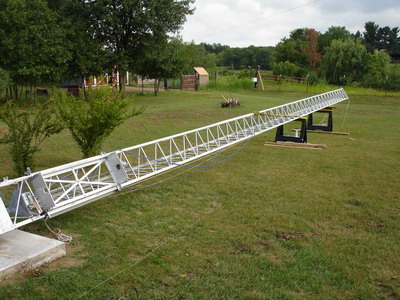Ham Radio Tower Installers
ROHN has been the world leader in tower design and tower manufacturing for more than seven decades. ROHN Amateur Radio Distributers. Ham Radio Outlet. 18 useful links about Antenna tower erectors collected in Shopping and Services/Antenna Tower Erectors. Antenna and tower installation services and ham radio.
Written by Steve Morris, K7LXC After working on over 150 amateur radio tower and antenna systems over the last 15 years, I have seen many problems and failures that could have, and should have, been avoided. By avoiding making these mistakes, you can make your tower and antenna system safer and more reliable. It'll even let you sleep nights better when that big storm blows through. Not following the manufacturer's specifications Commercially manufactured towers have to comply with current standards for wind loading and structural integrity.

Licensed Professional Engineers (PE's) design the towers and make the calculations to make them safe. If you don't follow their specs at a minimum, the tower will not take the stresses and loads that it is subject to. In other words, it'll probably fail. One of the immutable laws of antenna and tower construction is the LXC Prime Directive - 'DO what the manufacturer says'. Violation of this rule could be catastrophic. The inverse of this law is DON'T DO what the manufacturer DOESN'T SAY.
In other words, don't invent something that the manufacturer hasn't intended. Here are a couple of examples.
A ham was installing a KLM antenna that used the Lexan element brackets. After final assembly, he spray-painted the whole antenna with clear Krylon spray paint.
Because he always did that to protect his antennas. Unfortunately the Krylon reacted with the Lexan in the boom-to-element brackets and cracked all of them. Did the manufacturer say to do that? Here's another. Another amateur taped the bottom of the turnbuckles on the anchor end of his tower guy wires. Over time, the tape trapped water that eventually rusted the turnbuckle and he couldn't see it because it was covered up by the tape.
All it took was a medium-sized windstorm to break the turnbuckle and have the tower fail. Did the manufacturer say to tape the turnbuckles?
Not only did he do something the manufacturer didn't specify, but he also violated Mistake #8 below - Not doing an annual inspection. Korg Legacy Collection Mac Keygen. Overloading This is the most common reason for amateur tower failure. The first thing you need to know to plan and build a tower and antenna system is what the wind speed rating for your county is. Next, you need the manufacturer's specifications for that wind speed.
Then you must not exceed the wind load rating based on those factors. This is even more important for crank-up towers. Refer also to number 1. Let's face it, many amateurs overload their towers and get away with it.
I've seen tower installations that have violated just about every one of the ten mistakes and their installation has been up for 20 years. First of all the manufacturers have built in some amount of engineering overhead - sometimes 30 to 50%. And sometimes the tower is actually stronger than the engineer's specs. This over-engineering is done to increase long-term reliability, not to let you put more antennas on it. Another reason is that it might be sheer luck - after all, every time you speed you don't get a speeding ticket do you?
Whatever the reason, it's NEVER a good idea to overload anything. If in doubt, err on the side of conservatism - you'll never regret it.